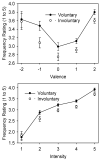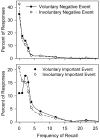Involuntary Memories and Dissociative Amnesia: Assessing Key Assumptions in PTSD Research
- PMID: 25309832
- PMCID: PMC4189812
- DOI: 10.1177/2167702613496241
Involuntary Memories and Dissociative Amnesia: Assessing Key Assumptions in PTSD Research
Abstract
Autobiographical memories of trauma victims are often described as disturbed in two ways. First, the trauma is frequently re-experienced in the form of involuntary, intrusive recollections. Second, the trauma is difficult to recall voluntarily (strategically); important parts may be totally or partially inaccessible-a feature known as dissociative amnesia. These characteristics are often mentioned by PTSD researchers and are included as PTSD symptoms in the DSM-IV-TR (American Psychiatric Association, 2000). In contrast, we show that both involuntary and voluntary recall are enhanced by emotional stress during encoding. We also show that the PTSD symptom in the diagnosis addressing dissociative amnesia, trouble remembering important aspects of the trauma is less well correlated with the remaining PTSD symptoms than the conceptual reversal of having trouble forgetting important aspects of the trauma. Our findings contradict key assumptions that have shaped PTSD research over the last 40 years.
Figures



References
-
- American Psychiatric Association . Diagnostic and statistical manual of mental disorders. 3rd ed. American Psychiatric Association; Washington, DC: 1980.
-
- American Psychiatric Association . Diagnostic and statistical manual of mental disorders. 3rd ed. rev American Psychiatric Association; Washington, DC: 1986.
-
- American Psychiatric Association . Diagnostic and statistical manual of mental disorders. 4th ed. American Psychiatric Association; Washington, DC: 1994.
-
- American Psychiatric Association . Diagnostic and statistical manual of mental disorders. 4th ed. Text Revision American Psychiatric Association; Washington, DC: 2000.
-
- Amir N, Stafford J, Freshman MS, Foa EB. Relationship between trauma narratives and trauma pathology. Journal of Traumatic Stress. 1998;11:385–392. - PubMed
Grants and funding
LinkOut - more resources
Full Text Sources
Other Literature Sources
